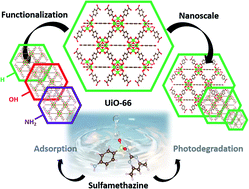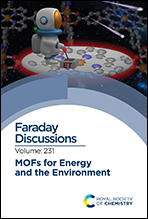Towards improving the capacity of UiO-66 for antibiotic elimination from contaminated water†
Abstract
Antibiotics are found in natural waters, raising concern about their human and environmental toxicity and the wide occurrence of antibiotic resistant bacteria. The antibiotic resistance crisis is attributed to the overuse and misuse of these medications. Particularly, sulfamethazine (SMT), an antibiotic commonly used in pigs and cattle for the treatment of bacterial diseases, has been detected in the natural environment (soil and water). Among all the technologies developed to combat the deteriorating water quality and control antimicrobial resistance, heterogeneous photocatalysis should be highlighted for the degradation of refractory organic compounds. Here, we described the SMT adsorption and photodegradation capacity of a highly porous and robust zirconium-based MOF UiO-66 under realistic conditions, and its potential recyclability. Further, its SMT removal capacity was improved by functionalizing the MOF porosity (28.5% of SMT adsorption in 24 h for nanoUiO-66-NH2), and nanosizing the MOF (100% SMT photodegradation in only 4 h for nanoUiO-66). Finally, the safety of the formed by-product during SMT photodegradation was confirmed, reinforcing the potential of the application of UiO-66 in water remediation.

- This article is part of the themed collection: MOFs for energy and environmental applications


 Please wait while we load your content...
Please wait while we load your content...